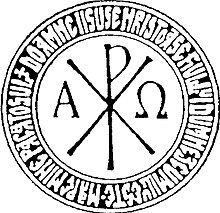
Back Jesusgebed Afrikaans Исусова молитва Bulgarian Pregària de Jesús Catalan Ježíšova modlitba Czech Jesusgebet German Προσευχή του Ιησού Greek Preĝo de Jesuo Esperanto Oración de Jesús Spanish Jeesuspalve Estonian Jeesuksen rukous Finnish
The Jesus Prayer,[a] also known as The Prayer,[b] is a short formulaic prayer, esteemed and advocated especially in Eastern Christianity and Catholicism:
Lord Jesus Christ, Son of God, have mercy on me, a sinner.

It is often repeated continually as a part of personal ascetic practice, its use being an integral part of the eremitic tradition of prayer known as hesychasm.[c] The prayer is particularly esteemed by the spiritual fathers of this tradition (see Philokalia) as a method of cleaning and opening up the mind and after this the heart (kardia), brought about first by the Prayer of the Mind, or more precisely the Noetic Prayer (Νοερά Προσευχή), and after this the Prayer of the Heart (Καρδιακή Προσευχή). The Prayer of the Heart is considered to be the Unceasing Prayer that the Apostle Paul advocates in the New Testament.[d] Theophan the Recluse regarded the Jesus Prayer stronger than all other prayers by virtue of the power of the Holy Name of Jesus.[3]
Though identified more closely with Eastern Christianity, the prayer is found in Western Christianity in the Catechism of the Catholic Church.[4] It also is used in conjunction with the innovation of Anglican prayer beads[5] (Rev. Lynn Bauman in the mid-1980s). The prayer has been widely taught and discussed throughout the history of the Eastern Catholic Church and Eastern Orthodox Church. The ancient and original form did not include the words "a sinner", which were added later.[3][6] The Eastern Orthodox theology of the Jesus Prayer as enunciated in the 14th century by Gregory Palamas was generally rejected by Latin Church theologians until the 20th century. Pope John Paul II called Gregory Palamas a saint,[7] a great writer, and an authority on theology.[8][9][10] He also spoke with appreciation of hesychasm as "that deep union of grace which Eastern theology likes to describe with the particularly powerful term "theosis", 'divinization'",[11] and likened the meditative quality of the Jesus Prayer to that of the Catholic Rosary.[12]
- ^ Ρωμανίδης, Ιωάννης Σ. (5–9 February 1982). Ο Ιησούς Χριστός-η ζωή του κόσμου [Jesus Christ-The Life of the World] (in Greek). Translated by Κοντοστεργίου, Δεσποίνης Δ. The Romans: Ancient, Medieval and Modern. Archived from the original on 13 August 2018. Retrieved 30 March 2019. Original: Romanides, John S. (5–9 February 1982). "Jesus Christ-The Life of the World". The Romans: Ancient, Medieval and Modern. Archived from the original on 8 February 2019. Retrieved 30 March 2019.
- ^ Romanides, John S. "Some underlying positions of this website reflecting the studies herein included". The Romans: Ancient, Medieval and Modern. Archived from the original on 19 November 2018. Retrieved 11 March 2019.
- ^ a b On the Prayer of Jesus by Ignatius Brianchaninov, Kallistos Ware 2006 ISBN 1-59030-278-8 pages xxiii–xxiv
- ^ "Catechism of the Catholic Church, § 2667". Vatican.va. Archived from the original on 7 January 2019. Retrieved 15 March 2019.
- ^ "Anglican Prayer Beads". King of Peace Episcopal Church. Archived from the original on 1 February 2019.
- ^ Frederica Mathewes-Green (2009). The Jesus Prayer: The Ancient Desert Prayer that Tunes the Heart to God. Paraclete Press. p. 76–. ISBN 978-1-55725-659-1.
- ^ Pape Jean Paul II (30 November 1979). "Messe à Ephèse". Vatican.va (in French). Archived from the original on 29 August 2018. Retrieved 16 March 2019.
- ^ Pope John Paul II (14 November 1990). "The Spirit as 'Love Proceeding'". Vatican.va. Archived from the original on 20 August 2002. Retrieved 16 March 2019.
- ^ Pope John Paul II (12 November 1997). "General Audience". Vatican.va. Archived from the original on 29 August 2018. Retrieved 16 March 2019.
- ^ Pope John Paul II (25 May 2000). "For the Jubilee of Scientists". Vatican.va. Archived from the original on 29 August 2018. Retrieved 16 March 2019.
- ^ Pope John Paul II (11 August 1996). "Eastern Theology Has Enriched the Whole Church". CatholicCulture.org. Archived from the original on 26 September 2007. Retrieved 16 March 2019.
- ^ Pope John Paul II (16 October 2002). "Apostolic Letter Rosarium Virginis Mariae". Vatican.va. Archived from the original on 27 October 2002. Retrieved 16 March 2019.
Cite error: There are <ref group=lower-alpha> tags or {{efn}} templates on this page, but the references will not show without a {{reflist|group=lower-alpha}} template or {{notelist}} template (see the help page).